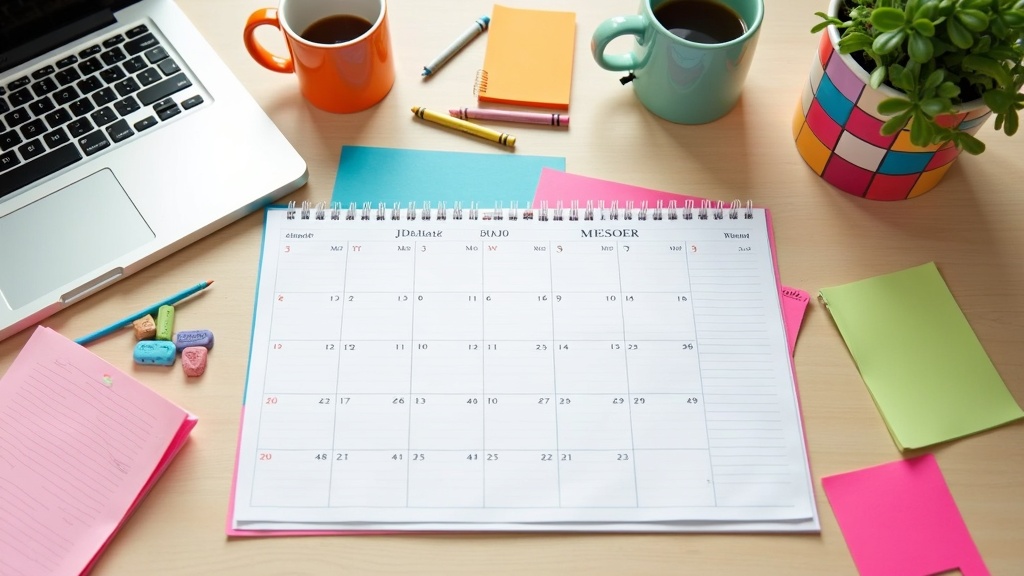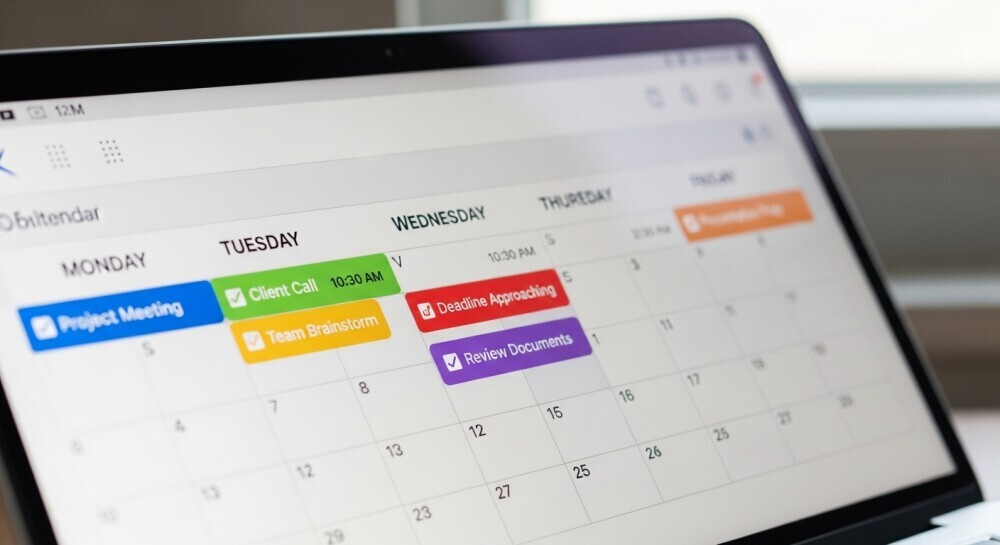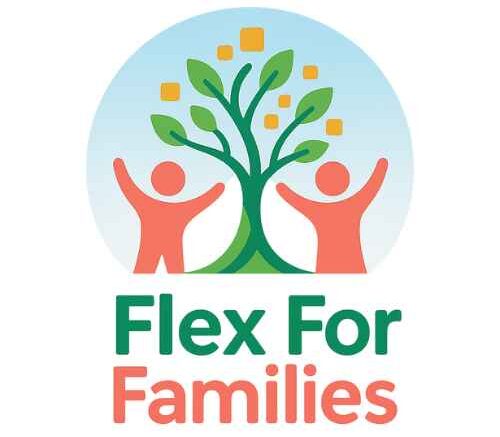Trying to keep your blog running while juggling family life? I’ve been there. Most content calendars come packed with boxes and deadlines, but life with kids rarely sticks to a tight script. Spilt juice, soccer practice, late-night colds… If you know, you know.
The typical plans that work for single creators or small businesses often fall apart in family homes because they’re built on perfection, not reality. What I’ve learned is, a content calendar should work with your family’s rhythms instead of locking you into a rigid routine.
Flexibility isn’t just helpful; it’s the key to showing up online without burning out at home.

Why a Flexible Content Calendar Wins for Parents
There’s a reason so many parent bloggers end up abandoning content plans: family life never follows the script. Early mornings sound productive until a sick day derails you. Nap times are gold, and then they disappear with a big growth spurt.

Instead of aiming for a perfect track record, I focus on building a system that bends when real life happens. Tiny wins add up. Consistency doesn’t mean posting every Monday at 7 am; it means showing up more often than not, even if that’s in pyjamas with a cup of cold coffee.
Flexibility lets you build a blogging habit that lasts, even on weeks that feel like a hurricane.
Step 1: Start with Your Real Routine
Building any content calendar starts by getting honest about how your days really run. I used to list “writing” blocks at night, only to fall asleep while the kids watched their pre-bedtime show.
Instead, I began with a weeklong family audit. What fixed commitments do you already have? School drop-offs, lunch prep, chores, dance class; write them down (I do this with a pen and paper or on Google Calendar).
Then look for work windows: maybe it’s half an hour after dinner, or snippets during nap time.

The Nap-Time Blogging Checklist helped me break big tasks into bite-sized jobs that fit into unpredictable days. Even if you only get one item done, that’s real progress. Planning with your real week in mind is much more sustainable than setting yourself up for frustration with wishful thinking.
The more you track your actual patterns, the easier it is to spot when you have energy and when you’re better off taking a break. Your family’s routine isn’t “wrong” if it doesn’t look like someone else’s productivity plan.
That’s exactly why a flexible content calendar is a parent blogger’s best ally – it grows with you and changes as your kids do.
Step 2: Choose a System That Fits You
I know there are tons of fancy apps and planners out there, but the best tool for your content calendar is the one you’ll actually use. I’ve tried everything from paper planners to Notion, and honestly, I still keep a Google Sheet as my backup. Some parents love a whiteboard on the fridge. Others prefer digital reminders that buzz their phone during that sweet, quiet hour after bedtime.

The system itself matters less than making it easy to update and adjust. If you’re new to this, keep it simple. Start with three columns: topic, draft due date, and publish date. Change it up as you go.
Here are a few common formats parents use:
- Paper Planners: Visual, easy to grab, and super helpful for families who like “seeing” the week.
- Google Sheets or Excel: Free, flexible, and easy to share with a partner; handy for quick edits and adjustments.
- Notion or Trello: Ideal for those who like digital cards or customisable templates, with room for notes and checklists.
I stick with Google Sheets for blog and social posts, since it syncs across my devices and lets me colour-code tasks when deadlines mix up. The right structure is whatever gets you planning out a week or month ahead—even if it’s in pencil.
Step 3: Batch Your Work by Energy, Not Just Time
When kids are little, “time management” feels like a myth. I found that batching blog work by my energy levels made much more sense. Mornings before the house wakes up are when I think best (hello, post outlines). Actual writing often happens during nap time or quiet play.
Light tasks like creating social media graphics, responding to comments, or tweaking post titles? I save those for the end of the day when my brain is a little tired, but my hands can still click around.

Here’s how I break it down:
- High-energy windows: Take on content creation: writing, outlining, filming reels.
- Mid-energy chunks: Edit, source images, add internal links, or research keywords.
- Low-energy moments: Schedule posts, publish, reply to blog comments, or share links in Facebook groups.
Instead of staring at a to-do list that feels impossible, I match my tasks to my mental space. That way, even chaotic weeks keep moving my blog forward, just at a pace that works for right now. And don’t forget: sometimes “low energy” is the perfect time to brainstorm future ideas without pressure… You can jot down quick thoughts on your phone while waiting in the pickup line or prepping dinner.
Step 4: Plan Themes, Not Just Posts
Trying to come up with brand new content ideas every week can get exhausting fast, so I started planning around loose themes, like “Monday Parenting Tips” or “Recipe Wednesdays.” This gives my calendar structure without boxing me in if plans change. If things fall apart (and they usually do), I just swap one post idea for another within the theme. It also helps readers know what to expect, while letting me play with variety.

Some simple theme ideas:
- “Meal Plan Monday” for easy dinners or lunchbox hacks
- “Wellness Wednesday” for family wellness, mental health, or routines
- “Feature Friday” for product reviews or affiliate spotlights (I stick to Fridays for any post that earns a little extra)
Themes give you a loose map, not a locked schedule. Planning in themes means you can brainstorm in batches: list a few recipe ideas for the month or draft some parenting tips during a quiet night. If you’re fresh out of ideas, Parent Blogging Hub is full of inspiration and helps you stay accountable—even on wild weeks.
Remember, the post order can always be mixed up. The main thing is making the calendar work for you, not the other way around.
Step 5: Review and Reset Monthly
No content plan sticks perfectly, especially around school holidays, illnesses, or surprise life stuff. At the end of each month, I spend about 20 minutes looking over what worked, what got skipped, and what felt too ambitious. I move incomplete ideas forward or let some things go. Trying to force past “failures” only makes burnout creep in faster.

Half the posts you plan might not go live this month. That’s totally normal. Progress is about showing up more consistently over time, not hitting 100%. If you track your wins (like the number of drafts written or photos uploaded) rather than just published posts, you’ll spot real growth, even when life’s messy. A reset gives you a much-needed reality check and helps you build a calendar that matches your family’s needs.
During monthly check-ins, think about which times of day worked best, what posts excited you, and where you felt stuck. This super detailed approach doesn’t have to be formal – just review, adjust, and carry lessons forward to the next month. Taking a small pause to see what’s actually working means you’re always making your content calendar more family-friendly.
Parent Tip: Don’t treat missed posts as failures – treat them as data for next month’s plan.
Creating a Calendar That Works For You, and With You
Building and sticking to a content calendar as a parent isn’t about squeezing yourself into someone else’s structure; it’s figuring out what rhythm actually fits your family’s current season.
Consistency grows out of flexibility and learning to give yourself a little grace when things go sideways. Small steps forward add up, and sometimes the best content happens in between snack breaks and bedtime stories.

If you’re looking for support and fresh ideas, Parent Blogging Hub is a great place for accountability, encouragement, and a community that “gets” the juggle. You can also check out the Nap-Time Blogging Checklist for simple daily actions when you’re short on time.
Remember: you’re not alone.
Every parent content creator has days when the plan falls apart and the calendar turns into colourful scribbles. Your willingness to try, adjust, and keep going is what sets you apart. And sometimes, your imperfect, honest stories are the ones that readers connect with the most.
Family Content Calendar FAQ
“How far ahead should I plan my content when family life is so unpredictable?”
I usually plan themes or general topics a month out, but only finalise post details a week in advance. That keeps stress low and expectations realistic.
“What if I miss a week? Should I even bother catching up?”
Skipped weeks happen. Just pick up with the next post and keep moving. Blogging through real life means rolling with the punches, not chasing perfect attendance.
“How can I stay motivated if hardly anything goes to plan?”
Celebrate tiny wins – one finished graphic, one new draft, one day you brainstormed titles in the carpool lane. The little bits count, and the Parent Blogging Hub is full of parents keeping each other going with accountability threads and real talk.
Final Thoughts
Building a family-first blog presence is about flexibility and self-compassion. Your content calendar exists to serve you, not stress you out. If you have more questions or want to chat about what’s working (or not!) with your process, drop me a line any time or join us in the Hub. I’m always happy to share what’s worked for me, even on the days when my calendar looks like a toddler’s colouring book.
You don’t need perfect timing to stay consistent. You just need the right support. 🌿
Your insight could be the spark that helps another parent find their flow — and that’s what our community is all about. 🌿




